Performance Improvement of the Free-Space Optical Communication Link Using Spatial Diversity Reception-Assisted OFDM Signals
Abstract
:1. Introduction
2. System Structure and Channel Model
3. Simulation Results and Discussion
3.1. Improvement Based on OFDM
3.2. Improvement Using Spatial Diversity
4. Conclusions
Author Contributions
Funding
Institutional Review Board Statement
Informed Consent Statement
Data Availability Statement
Acknowledgments
Conflicts of Interest
References
- Kaushal, H.; Kaddoum, G. Optical communication in space: Challenges and mitigation techniques. IEEE Commun. Surv. Tutor. 2017, 19, 57–96. [Google Scholar] [CrossRef] [Green Version]
- Henniger, H.; Wilfert, O. An introduction to free-space optical communications. Radioengineering 2010, 19, 203–212. [Google Scholar]
- Chan, V.W.S. Free-space optical communications. J. Lightwave Technol. 2006, 24, 4750–4762. [Google Scholar] [CrossRef]
- Gismalla, M.S.M.; Abdullah, M.F.L.; Sami, M.; Shah, N.S.M.; Das, B.; Qasim, A.A. Effect of Optical Attocells Deployment on the RMSD Spread in Indoor Visible Light Communication Systems. In Proceedings of the 2020 International Conference on Information Science and Communication Technology (ICISCT), Karachi, Pakistan, 8–9 February; pp. 1–6. [CrossRef]
- Wang, L.; Wang, J.; Tang, X.; Chen, H.; Chen, X. Performance analysis of a spatial diversity coherent free-space optical communication system based on optimal branch block phase correction. Opt. Express 2022, 30, 7854–7869. [Google Scholar] [CrossRef]
- Liu, W.; Yao, K.; Huang, D.; Lin, X.; Wang, L.; Lv, Y. Performance evaluation of coherent free space optical communications with a double-stage fast-steering-mirror adaptive optics system depending on the greenwood frequency. Opt. Express 2016, 24, 13288–13302. [Google Scholar] [CrossRef] [PubMed]
- Elsayed, E.E.; Yousif, B.B. Performance enhancement of the average spectral efficiency using an aperture averaging and spatial-coherence diversity based on the modified-PPM modulation for MISO FSO links. Opt. Commun. 2020, 463, 125463. [Google Scholar] [CrossRef]
- Gupta, R.; Kamal, T.S. Performance analysis of OFDM based FSO communication system with TCM codes. Optik 2021, 248, 168141. [Google Scholar] [CrossRef]
- Erdogan, E.; Altunbas, I.; Kabaohlu, N.; Yanikomeroglu, H. A cognitive radio enabled RF/FSO communication model for aerial relay networks: Possible configurations and opportunities. IEEE Open J. Veh. Technol. 2020, 2, 45–53. [Google Scholar] [CrossRef]
- Shieh, W.; Bao, H.; Tang, Y. Coherent optical OFDM: Theory and design. Opt. Express 2008, 16, 841–859. [Google Scholar] [CrossRef]
- Gismalla, M.S.M.; Abdullah, M.F.L.; Ahmed, M.S.; Mabrouk, W.A.; AL-Fadhali, N.; Saeid, E.; Supa’at, A.S.M.; Das, B. Design and analysis of different optical attocells deployment models for indoor visible light communication system. Int. J. Integr. Eng. 2021, 13, 253–264. [Google Scholar] [CrossRef]
- Jansen, S.; Borne, D.; Adhikari, S. Past, Present and Future of Optical OFDM. In Proceedings of the Communications and Photonics Conference and Exhibition (ACP, 2009), Shanghai, China, 2–6 November 2009; pp. 1–5. [Google Scholar] [CrossRef]
- Sharma, V.; Sushank. High speed CO-OFDM-FSO transmission system. Opt. Int. J. Light Electron. Opt. 2014, 125, 1761–1763. [Google Scholar] [CrossRef]
- Shieh, W.; Athaudage, C. Coherent optical orthogonal frequency multiplexing. Electron. Lett. 2006, 42, 587–589. [Google Scholar] [CrossRef] [Green Version]
- Cvijetic, N.; Qian, D.; Wang, T. 10Gb/s Free-Space Optical Transmission Using OFDM. In Proceedings of the Optical Fiber Communication Conference (p. OThD2), Optical Society of America, San Diego, CA, USA, 24–28 February 2008. [Google Scholar] [CrossRef]
- Khichar, S.; Inanyia, P. Evaluation of performance of Is-OWC OFDM system with spatial diversity. Opt. Wirel. Technol. 2020, 2020, 49–55. [Google Scholar]
- Mohaisen, M.; Wang, Y.; Chang, K. Multiple antenna technologies. arXiv 2009, arXiv:0909.3342. [Google Scholar] [CrossRef]
- Wang, Y.; Zhu, L.; Feng, W. Performance study of wavelength diversity serial relay OFDM FSO system over exponentiated Weibull channels. Opt. Commun. 2021, 478, 126470. [Google Scholar] [CrossRef]
- Islam, M.; Majumder, S. Analytical evaluation of the cross-polarization induced crosstalk on BER performance of an OFDM FSO link with polarization diversity. Opt. Commun. 2020, 474, 126095. [Google Scholar] [CrossRef]
- Abaza, M.; Mesleh, R.; Mansour, A.; Aggoune, E. Spatial Diversity for FSO Communication Systems over Atmospheric Turbulence Channels. In Proceedings of the 2014 IEEE Wireless Communications and Networking Conference (WCNC), Istanbul, Turkey, 6–9 April 2014; pp. 382–387. [Google Scholar] [CrossRef]
- Abadi, M.; Ghassemlooy, Z.; Smith, D.; Ng, W.; Zvanovec, S. Comparison of Different Combining Methods for Space-Diversity FSO Systems. In Proceedings of the 9th IEEE/IET International CSNDSP14 IEEE, Manchester, UK, 23–25 July 2014; pp. 1023–1028. [Google Scholar] [CrossRef]
- Yu, Z.; Cai, R.; Wu, Z.; He, H.; Jiang, H.; Feng, X.; Zheng, A.; Chen, J.; Gao, S. Performance evaluation of direct-detection coherent receiver array for free-space communications with full-link simulation. Opt. Commun. 2020, 454, 124520. [Google Scholar] [CrossRef]
- Karagiannidis, G.; Zogas, D.; Sagias, N.; Kotsopoulos, S.; Tombras, G. Equal-gain and maximal-ratio combining over nonidentical Weibull fading channels. IEEE Trans. Wirel. Commun. 2005, 4, 841–846. [Google Scholar] [CrossRef]
- Sun, J.; Huang, P.; Yao, Z.; Guo, J. Adaptive digital combining for coherent free space optical communications with spatial diversity reception. Opt. Commun. 2019, 444, 32–38. [Google Scholar] [CrossRef]
- Zheng, A.; Huang, Y.; Gao, S. Modeling and spatial diversity-based receiving improvement of in-flight UAV FSO communication links. Appl. Sci. 2021, 11, 6365. [Google Scholar] [CrossRef]

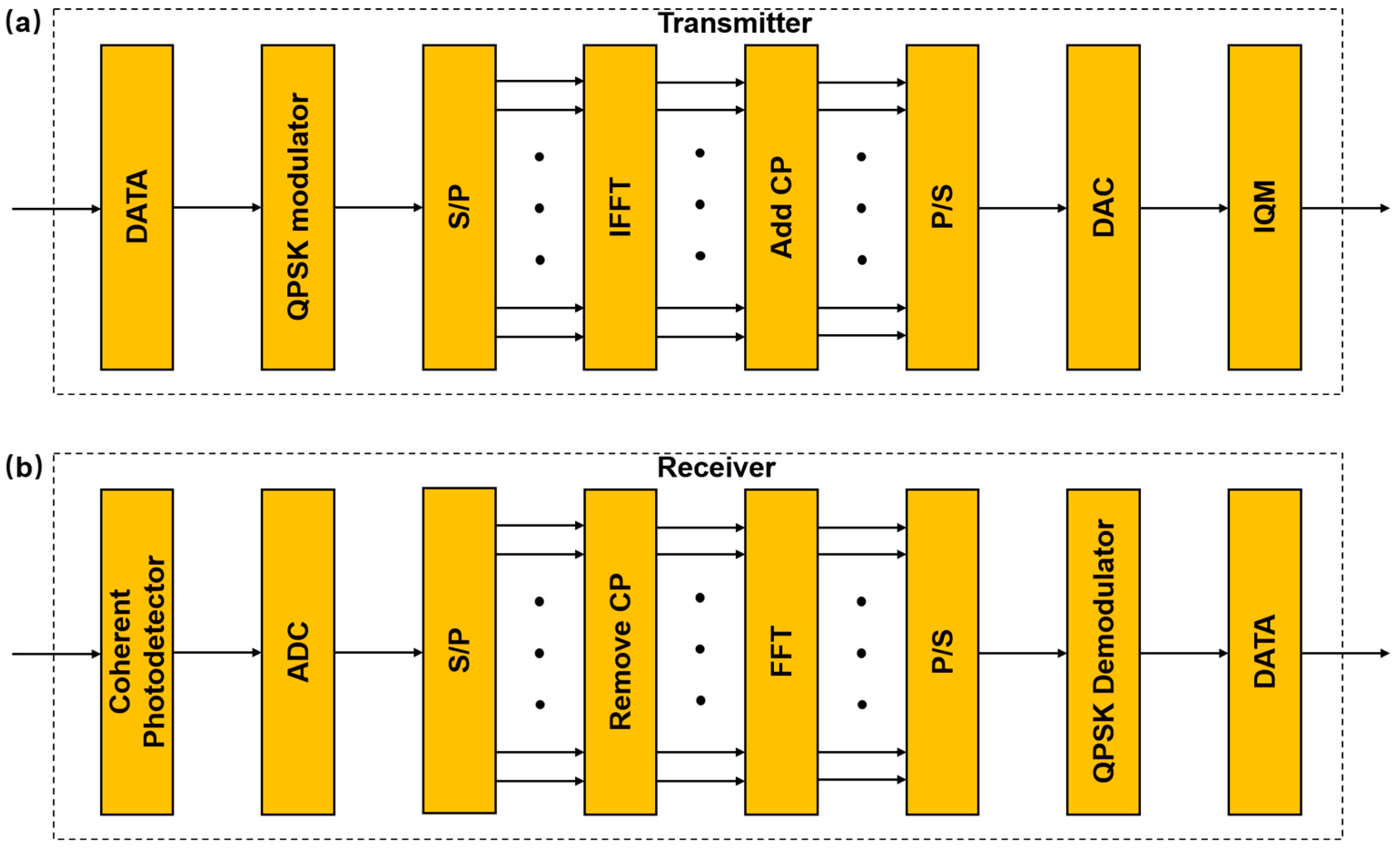
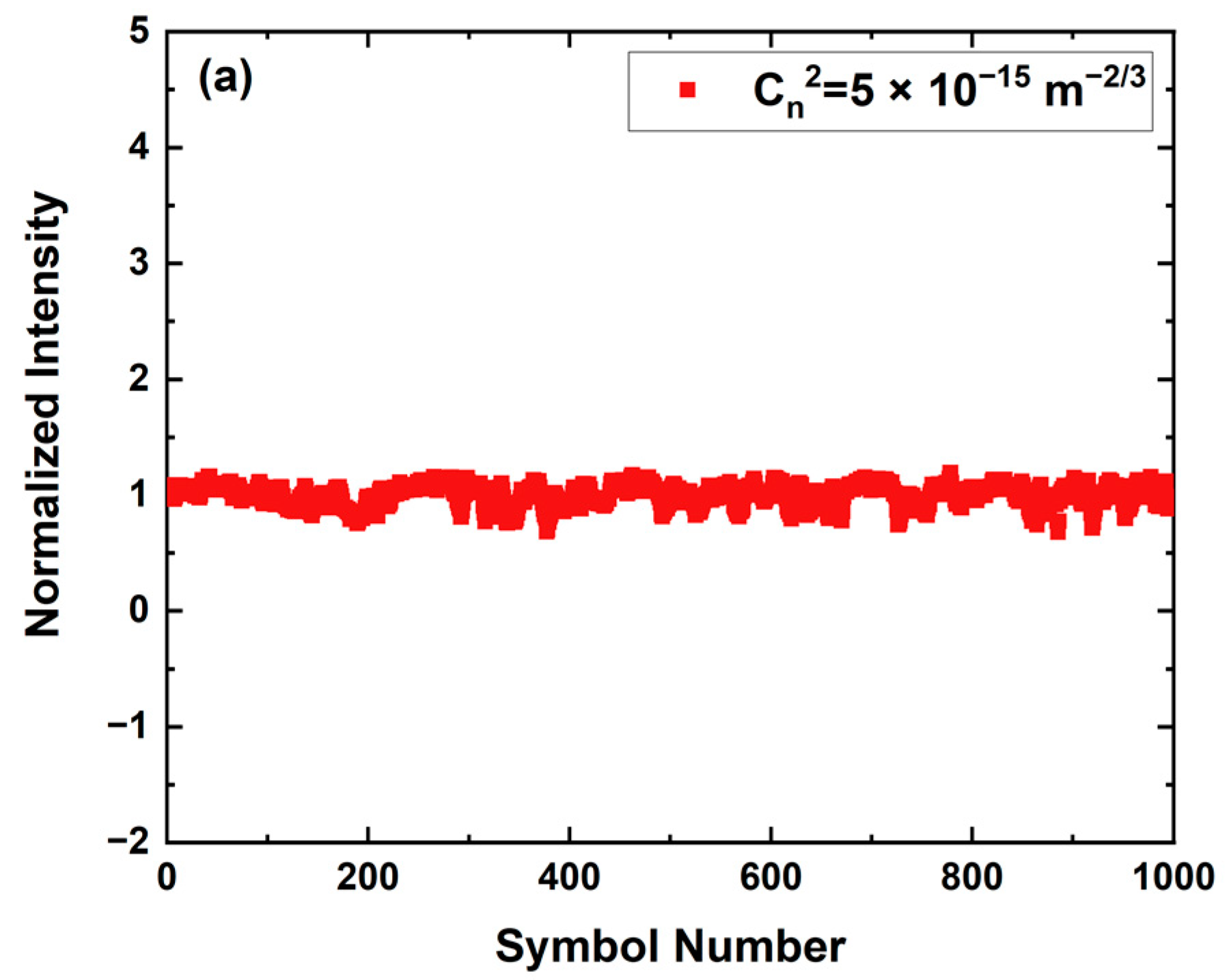
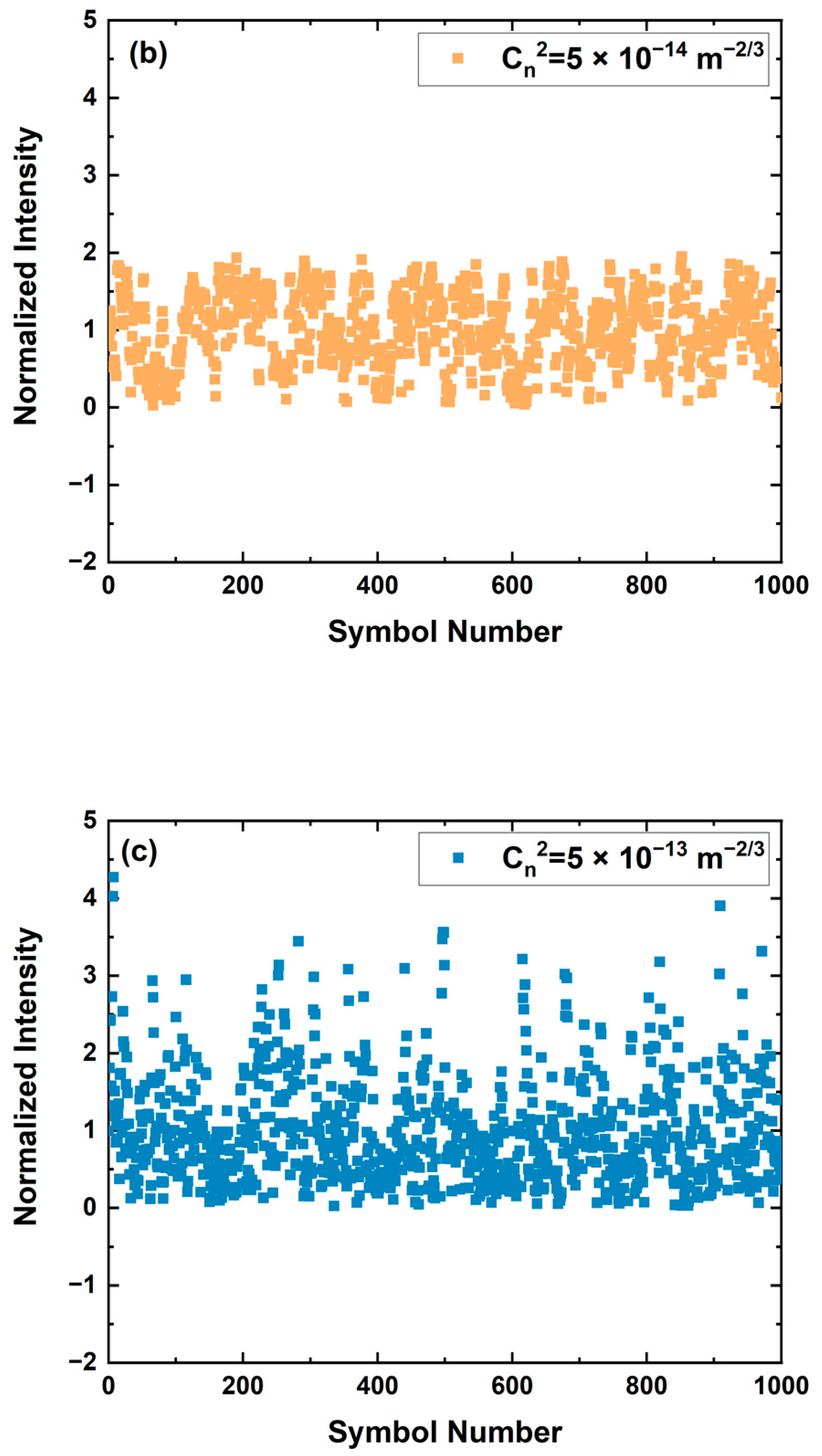
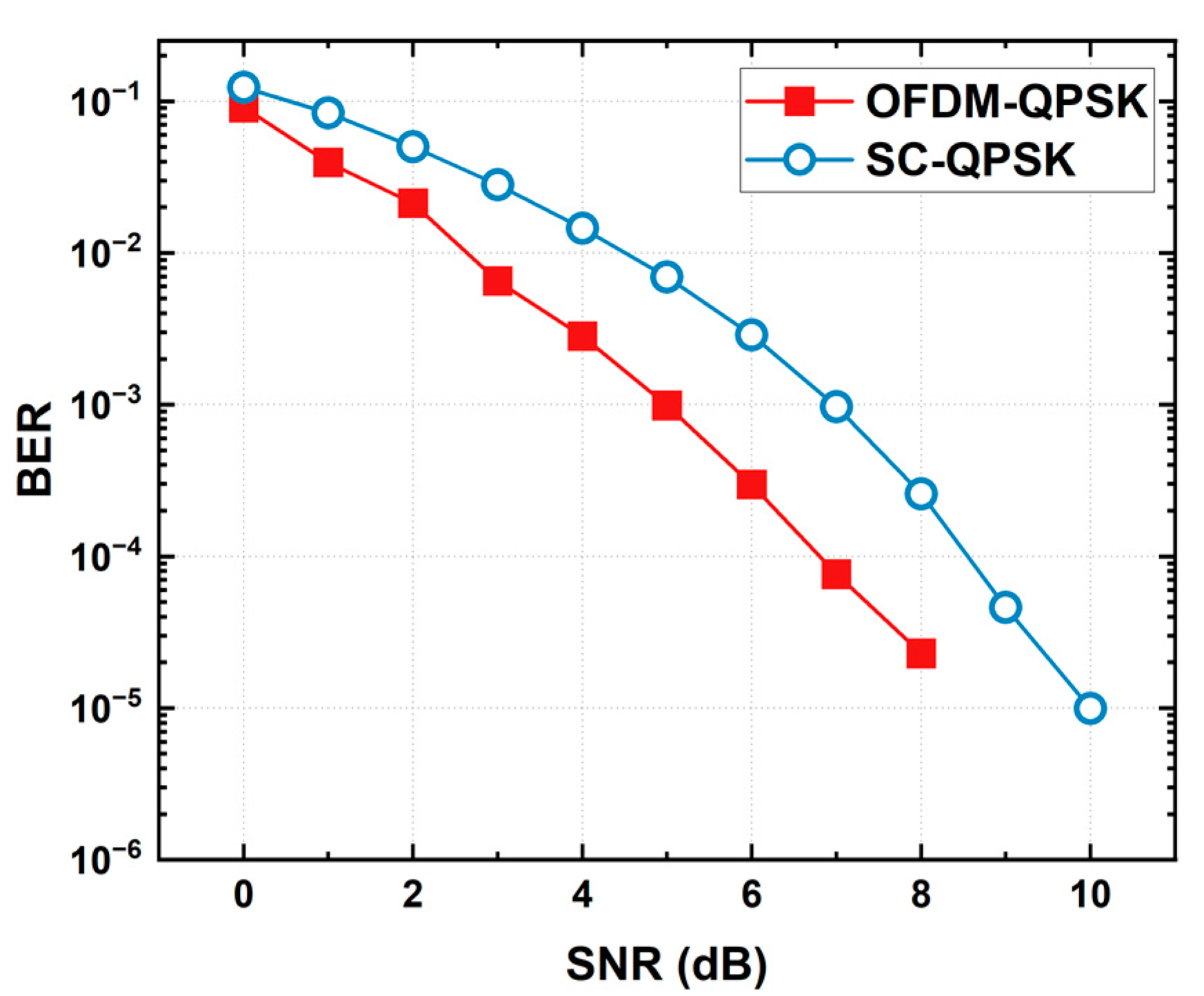
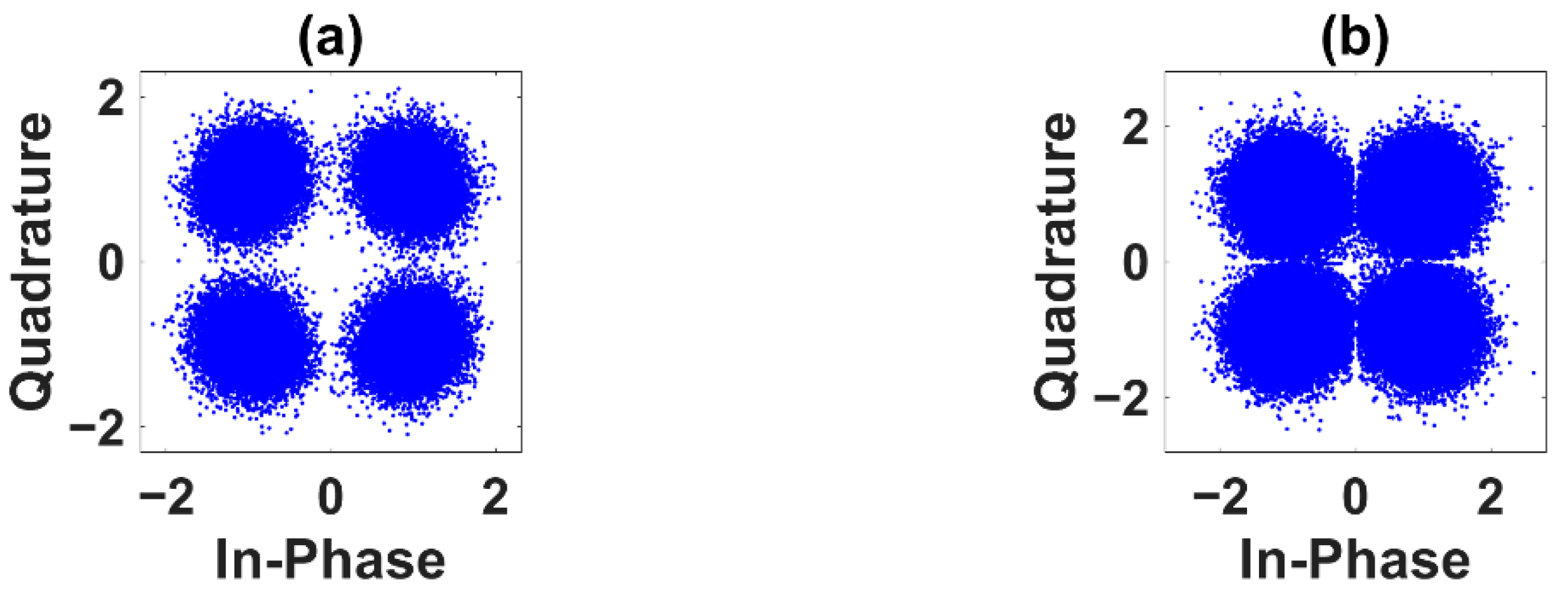
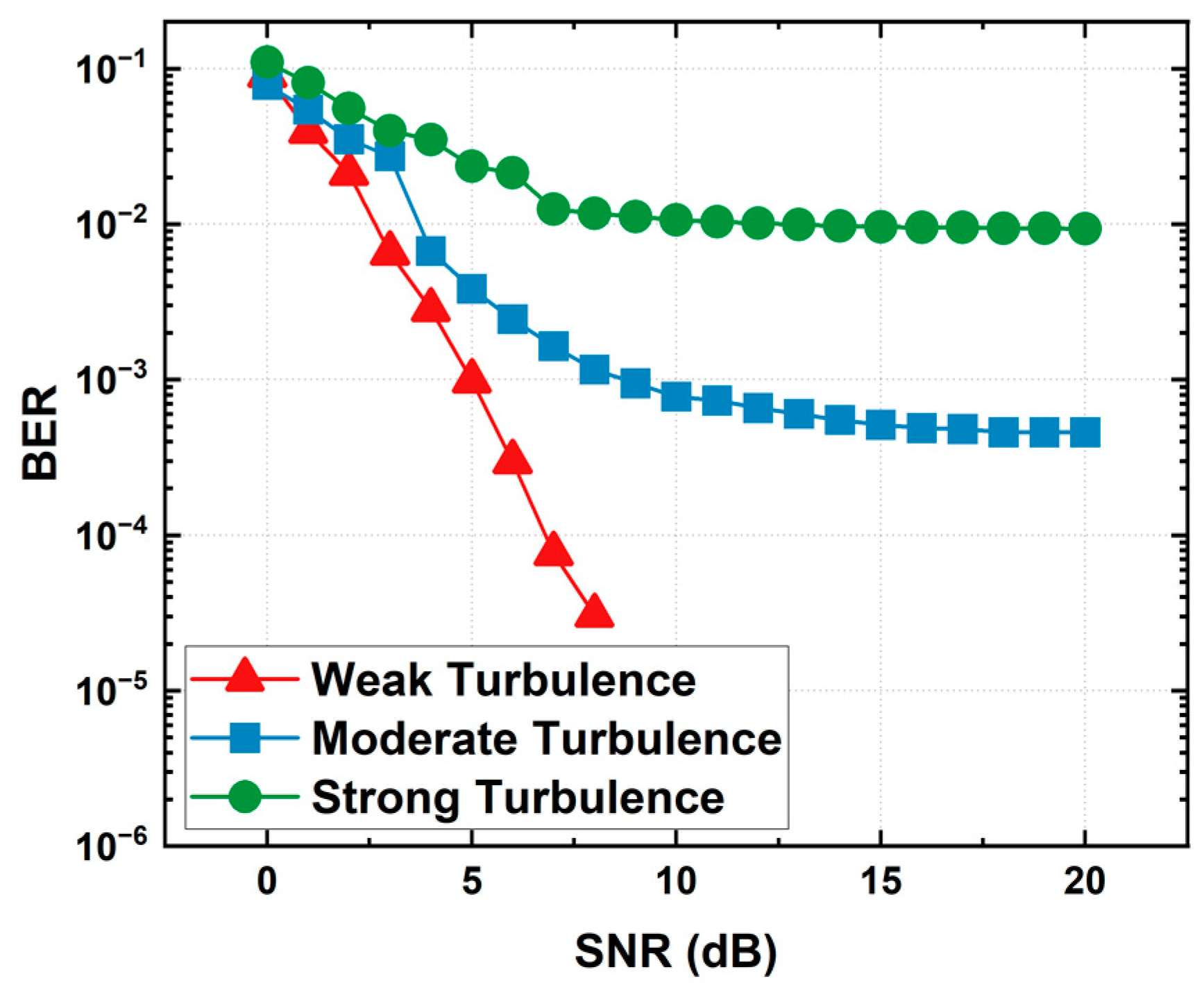
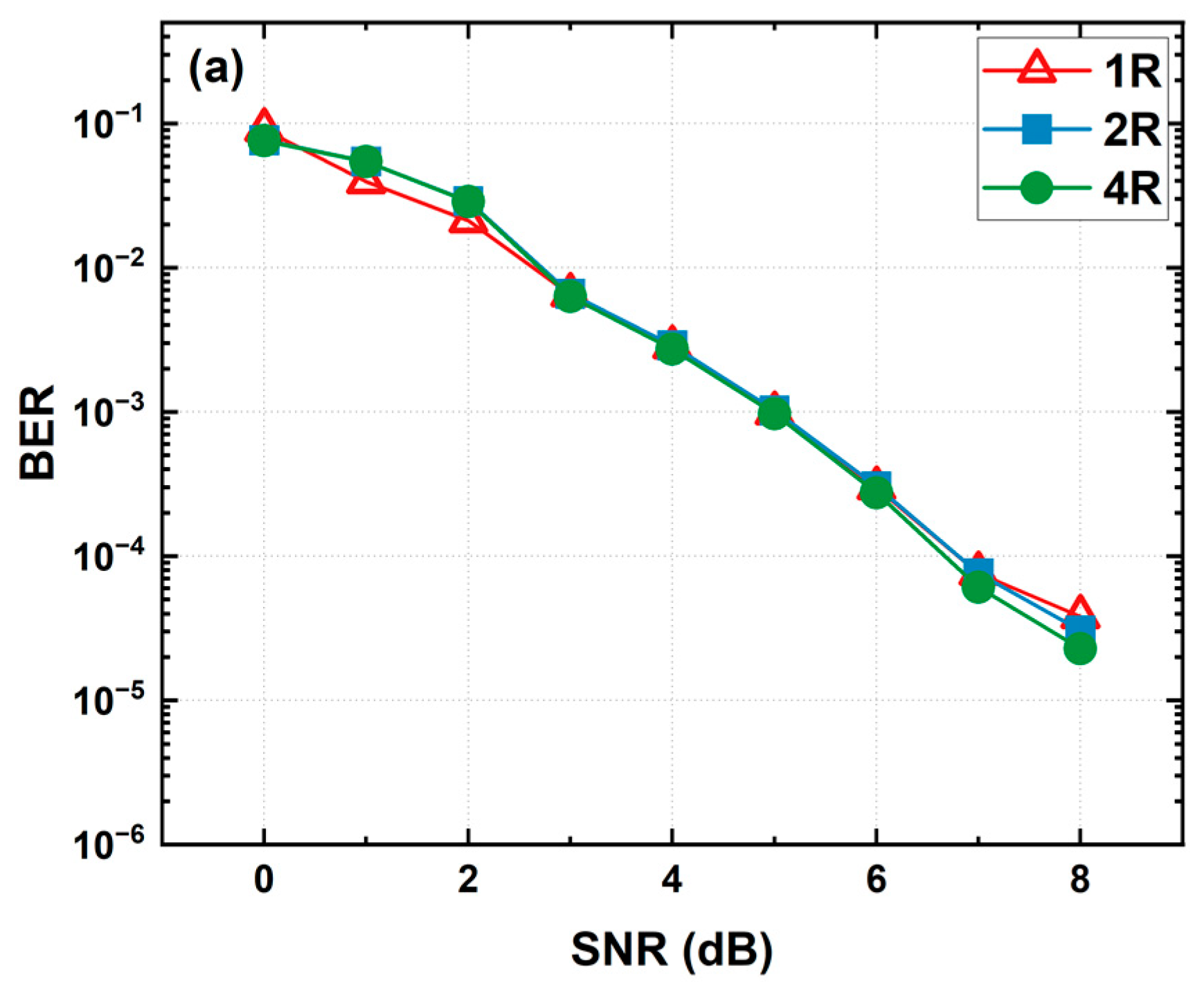
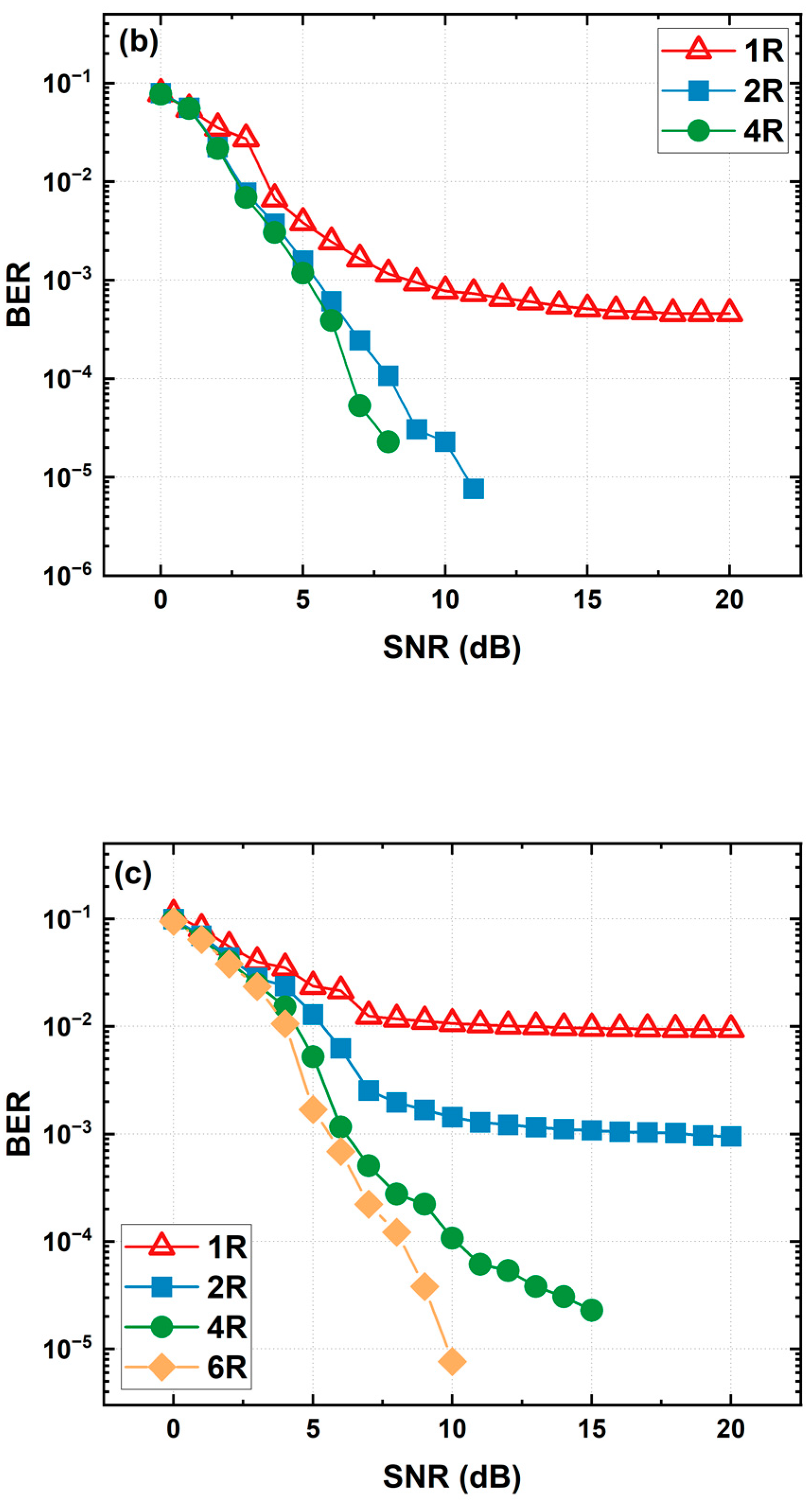
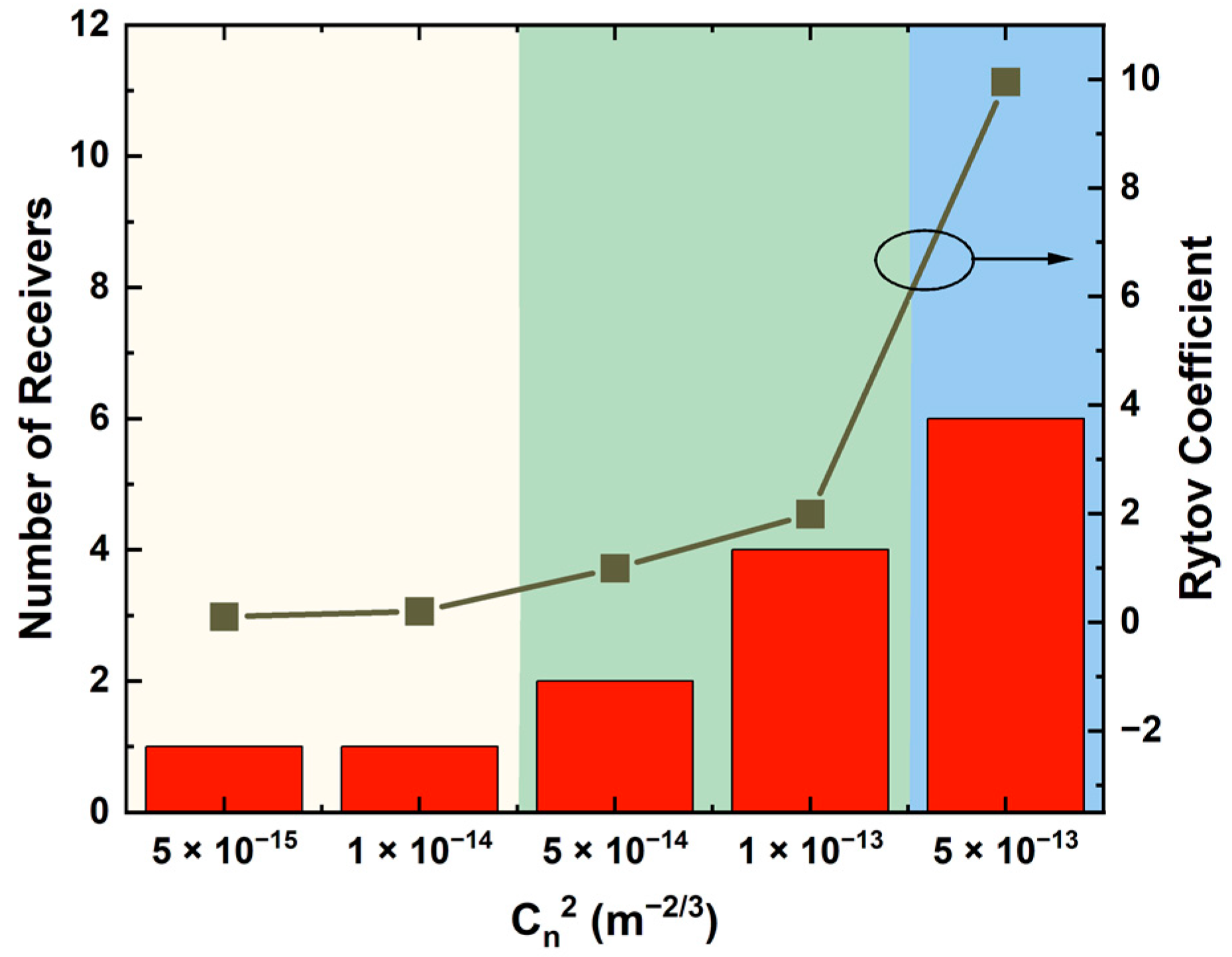
| Symbol | Value |
|---|---|
| Wavelength, λ | 1550 nm |
| Link distance, L | 1000 m |
| Phase screen size | 0.5 m × 0.5 m |
| Inner scale, l0 | 0 |
| Outer scale, L0 | 100 m |
| Refractive-index structure parameters, | (weak turbulence) |
| (moderate turbulence) | |
| (strong turbulence) |
Publisher’s Note: MDPI stays neutral with regard to jurisdictional claims in published maps and institutional affiliations. |
© 2022 by the authors. Licensee MDPI, Basel, Switzerland. This article is an open access article distributed under the terms and conditions of the Creative Commons Attribution (CC BY) license (https://creativecommons.org/licenses/by/4.0/).
Share and Cite
Huang, Y.; Zheng, X.; Guo, Y.; Gao, S. Performance Improvement of the Free-Space Optical Communication Link Using Spatial Diversity Reception-Assisted OFDM Signals. Appl. Sci. 2022, 12, 6828. https://doi.org/10.3390/app12146828
Huang Y, Zheng X, Guo Y, Gao S. Performance Improvement of the Free-Space Optical Communication Link Using Spatial Diversity Reception-Assisted OFDM Signals. Applied Sciences. 2022; 12(14):6828. https://doi.org/10.3390/app12146828
Chicago/Turabian StyleHuang, Yang, Xinyi Zheng, Yufei Guo, and Shiming Gao. 2022. "Performance Improvement of the Free-Space Optical Communication Link Using Spatial Diversity Reception-Assisted OFDM Signals" Applied Sciences 12, no. 14: 6828. https://doi.org/10.3390/app12146828
APA StyleHuang, Y., Zheng, X., Guo, Y., & Gao, S. (2022). Performance Improvement of the Free-Space Optical Communication Link Using Spatial Diversity Reception-Assisted OFDM Signals. Applied Sciences, 12(14), 6828. https://doi.org/10.3390/app12146828






